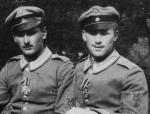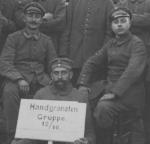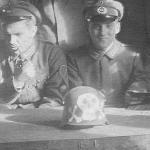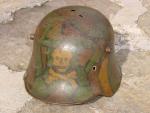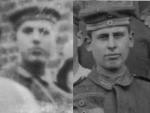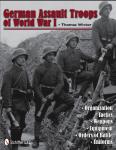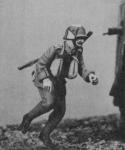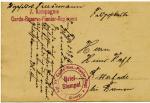
Thomas W
For Deletion-
Posts
788 -
Joined
-
Last visited
-
Days Won
3
Content Type
Profiles
Forums
Blogs
Gallery
Events
Store
Everything posted by Thomas W
-
By the way, since this is the Flammenwerfer-Totenkopf thread, in case anyone is interested I recently discovered that I have in my collection a photo of the father of one of the people who sometimes comments here, Bob Lembke. Bob confirmed that this is indeed his father, Pionier Georg Lembke, 2. Kompagnie, Garde-Reserve-Pionier-Regiment. I never forget a face, and Bob had sent me an image of his father years ago. My photo shows Bob and the 1st Platoon of his company about to go into battle at Verdun, very likely on December 28, 1916, the day Bob's father was terribly wounded on the Dead Man. My photo is on the left, and Bob's is on the right, taken two years later.
-
That's the theory of the Webmaster. Personally, I don't think the chalk signboard in question refers to the troops' preference for a symbol. For example, there are lots of chalk signboards with drawings of pistols, grenades, horseshoes, trench guns, etc. The flamethrower pioneers had their dedicated unit since October of 1914, but they didn't received the sleeve badge until July of 1916. That's quite a long time to go without having any special insignia, particularly since hand-grenade throwers and shock troops had been wearing their own informal badges since late 1915 or so. I think when the Crown Prince recommended the Totenkopf to the Kaiser, the two of them were making an extremely Prussian statement about their own patronage of this regiment. I think the Prussian Totenkopf represented the elite status of the unit rather than its dangerous missions. On the other hand, I think the chalkboard Totenkopf drawn by the men of Flammenwerfer-Abteilung Reddemann is the equivalent of a skull-and-crossbones on a jar of rat poison or a sign on a minefield. I have lots of photos of flamethrower pioneers taken prior to the awarding of the Prussian Totenkopf. You'd think that if they wanted to be identified with a Totenkopf at least a few of them would have put one on before July of 1916, especially since so many other assault troops were wearing unofficial badges by then. But so far the 1914 photo is the only one I've seen associating flamethrower pioneers with a Totenkopf before the official badge was awarded.
-
Okay, another layer to the Flammenwefer-Totenkopf story: This link was posted here a little earlier: http://www.tapferes-...lungsgeschichte I asked the Web master for a high-res copy of the photo at the top of the page, and he agreed, under the condition that I not post it anywhere else. It turns out that the photo shows members of Flammenwerfer-Abteilung Reddemann in late 1914, sitting with Richard Fiedler, inventor of the flamethrower, and they've got a Totenkopf drawn on the signboard. The photo was taken at a factory in Westphalia, where they later built the Kleif M.1915, the weapon that looks very different from all the other Fiedler designs used by the flamethrower battalions and regiment. I've traced an exact outline of the Totenkopf on the sign. It was drawn in chalk, which is why it looks so crude. To me, it's clearly a reference to "poison" or "danger" rather than any military unit or any part of German heritage. The original Fiedler flamethrowers were designed to spray either flame or poison gas; in fact, the Germans used flamethrowers to spray poison gas at Rawa on June 6, 1915. So, I disagree with the Webmaster of the site, whose theory is that the flamethrower pioneers originated their Totenkopf insignia and then the higher authorities later approved it. According to my research, the Prussian-style Totenkopf worn by the flamethrower pioneers had a lot of historical and cultural significance, and the badge was considered a formal award, suggested by the Crown Prince and apporved by the Kaiser. I think the chalk Totenkopf drawn on the signboard by the members of Flammenwerfer-Abteilung Reddemann only represents "poison" or "Beware!" These men see themselves as dangerous dealers of death from flame and gas, so they label themselves as such.
-
The Freikorps units were virtually banned by the National Disarmament Law (Entwaffnungsgesetz) of 1920. Some Freikorps units were absorbed into the Reichswehr and continued to wear their insignia until about 1921. Essentially you're right. After November 11, 1918 the official flamethrower Totenkopf was banned, and after August 11, 1920, most Freikorps insignia were banned. By the way, I've exchanged e-mails with the guy who runs the Web site with the embroidered badge, and he says he'll send me a high-resolution copy of the photo of the "Flammen-Kommando" that has a Totenkopf on the signboard. I think it dates from 1914. That would be pretty fascinating if true.
-
You're right. White cotton. You don't see too many photos of flamethrower Totenkopf badges--even the nonofficial ones--after the early 1920's. I'll bet that since there were so many Freikorps guys wearing Totenkopfen all over their unifroms, what happened was the flamethrower pioneers simply stopped wearing theirs. When you perceive yourself as an elite and then suddenly see every Tom, Dick, or Harry wearing similar insignia, you don't want to be considered just another schlub.

